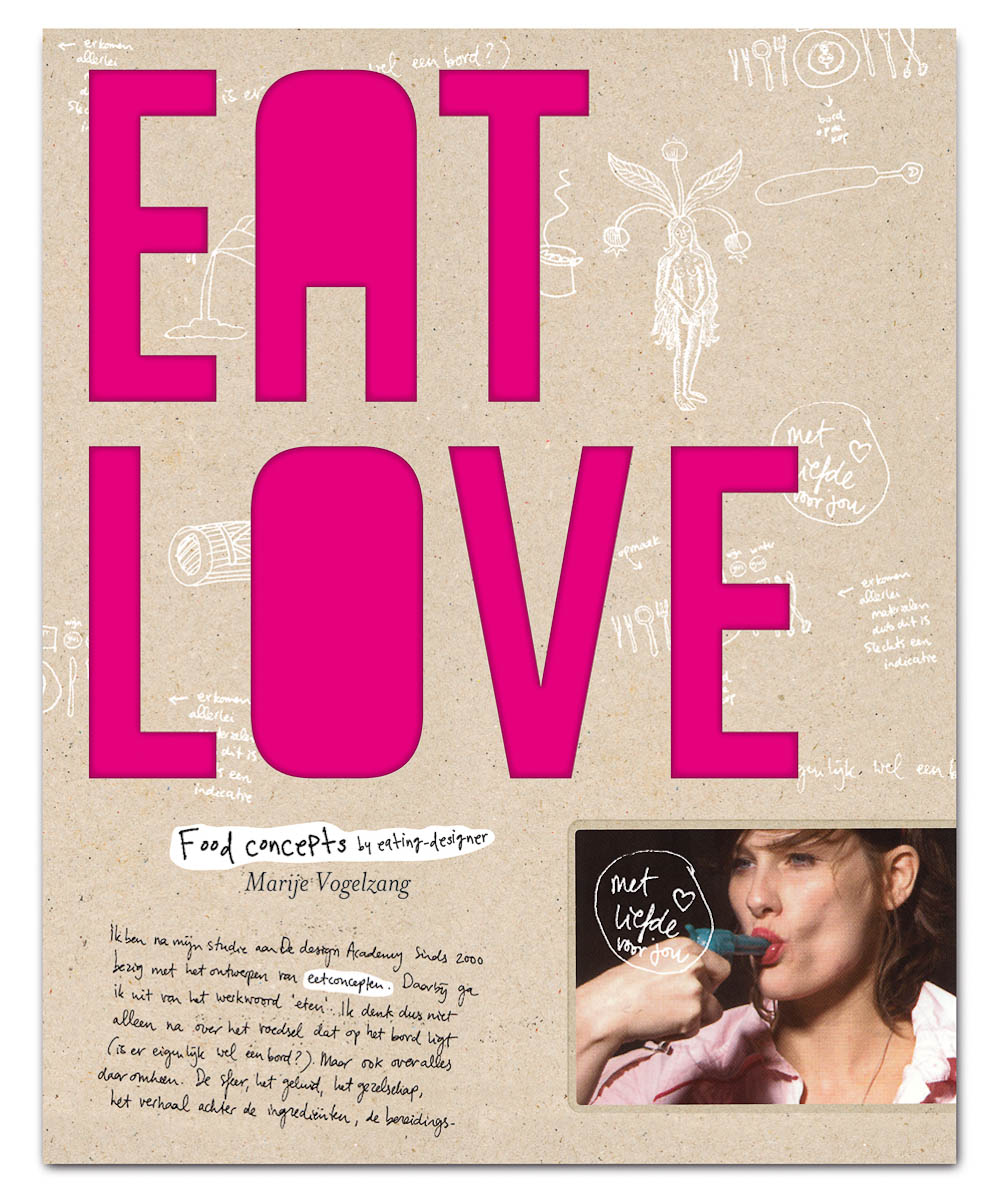
Eat Love
Food Concepts by Eating-Designer Marije Vogelzang
Louise Schouwenberg
After her graduation from the Design Academy in Eindhoven in 2000 Marije Vogelzang has been designing eating concepts. Her interest is in the verb ‘to eat’. Not only does she think deeply about what is on the plate (if there is a plate at all), but she also thinks about everything that surrounds the act of eating. The atmosphere, the people involved, the stories behind the ingredients, the taste and texture, sound, smell and colour of food and the way it is prepared and served. She explores the intimacy of design that actually goes inside your body and follows the journey of food from seed all the way to poop. Thinking about all this and working and experimenting in her studio and restaurant and by creating eating experiences for her clients she has developed her own unique way of looking at eating from a psychological, cultural and design point of view.
This book makes her vision and spectacular eating concepts available for the first time for a large group of people who are interested in food and the culture and experience of eating. The book is written by design critic Louise Schouwenberg and places Marije Vogelzang’s work in context of Dutch design, international design and trends in food, eating culture and society.
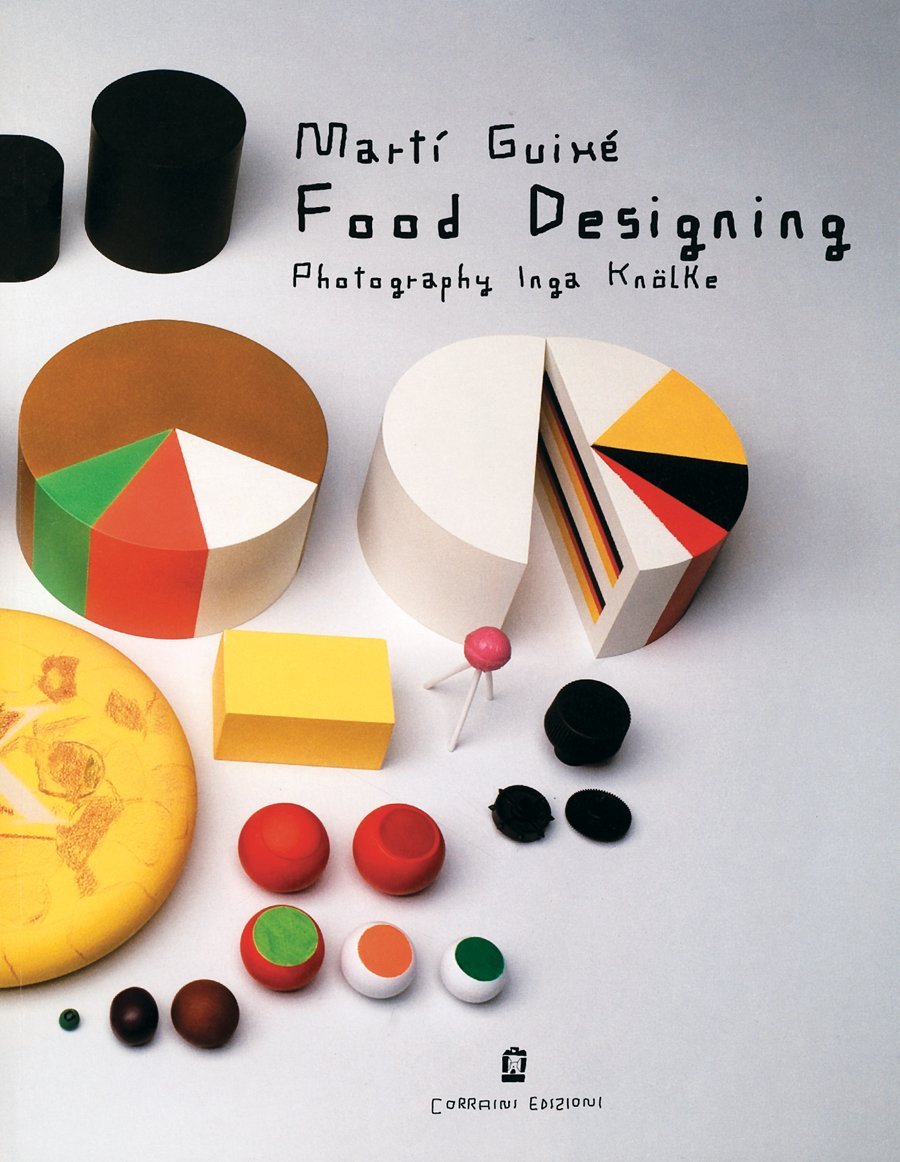
Food designing
Martí Guixé. – 1. ed. – Mantova : Corraini Ed., 2010
Even food can be a design item. Self-professed „ex-designer“ Martí Guixé (born 1964) offers countless whimsical examples: squaring potatoes, building molecular structures with olives and toothpicks and decorating cakes with graphic representations of their contents. Martí Guixé: Food Designing documents his projects from 1995 to the present.
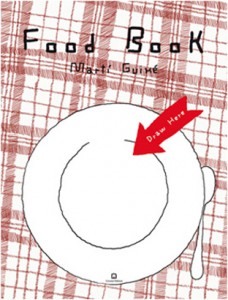
Food Book
Marti Guixe. – Mantova : Corraini Ed., 2009
After ‚Blank Book‘ and ‚Tattoo Book‘, let’s draw fragrant pastas, delicious meats and succulent desserts in Martí Guixé’s new book: ‚Food Book‘! Each page is a tasty graphical suggestion to be “filled in” by each fellow dinner, from the starters to the coffee, satisfying the desires of the very moment or conceiving an elaborate menu. No matter if you love traditional or exotic cuisine, Food Book is a banquet on paper with your favourite courses, and also the right way to improvise in cooking without any risk …
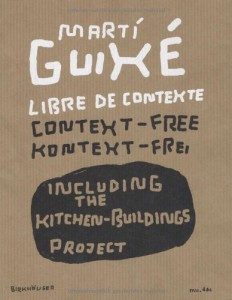
Marti Guixé – Libre de contexte
Basel [u.a.] : Birkhäuser, 2003
Der „Ex-Designer” und Künstler Martí Guixé lebt zwischen Berlin und Barcelona und anderswo. Seine Arbeiten zeichnen sich aus durch die Einfachheit der Formen und Materialien, durch eine unscheue Ironie für die Dinge, die ihn umgeben. Das „Kitchen-Buildings”-Projekt besteht aus mobilen Konstruktionen für die Zubereitung von Speisen: Kochen, eine simple Freizeitbeschäftigung. Dieses Buch zeigt viel unveröffentlichtes Material und zeichnet sich besonders durch die zahlreichen comichaften Anleitungen und Skizzen aus der Hand des Künstlers sowie durch die aufschlussreichen Texte zu den einzelnen Werken aus.
Textauszüge bei Google Books:
Marti Guixé – Libre de contexte
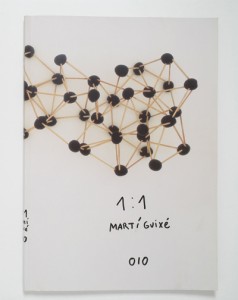
1:1 – Martí Guixé
Rotterdam : 010 Publishers, 2002
Guixé’s aim is to provide people with a ‚mandorla‘, a Catalan word that can loosely be translated as ‚aura of well-being‘. He is an extremely productive creator of ideas (something like five a day) that may deal with manuals for making toys out of coat hangers, functional tattoos or interior decoration for aquariums. This A3 picture book provides a humorous overview of his work. It consists entirely of 1:1 photographs of objects, drawings and texts.
Textauszüge bei Google Books:
One to one, Martí Guixé
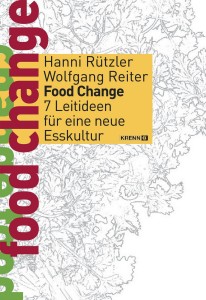
Food Change
7 Leitideen für eine neue Esskultur
Hanni Rützler. – Wien : Krenn, 2010
Unsere Welt it im Wandel. Und damit auch die Welt des Essens. Innovative Konzepte in der Landwirtschaft, in der Nahrungsmittelproduktion, im Handel und der Gastronomie verändern unsere Esskultur ebenso wie ein kritischer und bewußter Konsum. Die 7 Leitideen für eine neue Esskultur zielen nicht bloß auf eine wertneutrale Prognose einer zukünftigen, sondern verstehen sich vor allem als Anregung zur Entwicklung einer besseren Esskulltur. Sie geben uns einen Vorgeschmack davon, was möglich ist, aber auch was alles nötig ist, damit uns die Zukunft besser schmeckt.
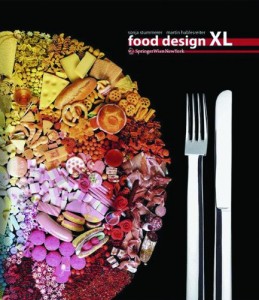
Food design XL
Sonja Stummerer. – Wien [u.a.] : Springer, 2010
Warum sind Pizzas rund und Fischstäbchen rechteckig? Warum zerschneiden wir eine Torte anders als ein Brot? Auf diese und ähnliche Fragen gab das 2005 mit internationalen Preisen gewürdigte Buch „Food Design“ bereits erste Antworten. Nun präsentieren die Autoren eine zweisprachige Maxi-Ausgabe. Darin widmen sie sich der Frage, wie Form, Farbe, Geruch, Konsistenz, Verzehrgeräusche, Herstellungstechnik, Geschichte und Geschichten das Design von Lebensmitteln beeinflussen.
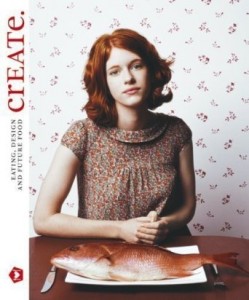
CrEATe – Eating, design and future food
Robert Klanten. – Berlin : Gestalten, 2008
Food is not just a hot topic in design and cutting edge creativity today, but also an enormous industry with changing standards and perceptions. Based upon research by trend analysts from the London firm The Future Laboratory, crEATe. investigates recent trends and visual developments in and around food. The book examines everything from the way we eat, the interiors and furniture of innovative restaurants and shops, industrial design and the packaging of food to branding and consumerism. With incisive texts including profile features accompanied with stunning visuals, this sourcebook indicates how food is gaining new meaning in our lives and in top-notch contemporary design.
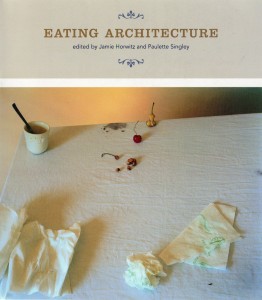
Eating architecture
Jamie Horwitz. – Cambridge, Mass [u.a.] : MIT Press, 2004
The contributors to this highly original collection of essays explore the relationship between food and architecture, asking what can be learned by examining the (often metaphorical) intersection of the preparation of meals and the production of space.
The essays are organized into four sections that lead the reader from the landscape to the kitchen, the table, and finally the mouth. The essays in „Place Settings“ examine the relationships between food and location that arise in culinary colonialism and the global economy of tourism. „Philosophy in the Kitchen“ traces the routines that create a site for aesthetic experimentation, including an examination of gingerbread houses as art, food, and architectural space. The essays in „Table Rules“ consider the spatial and performative aspects of eating and the ways in which shared meals are among the most perishable and preserved cultural artifacts. Finally, „Embodied Taste“ considers the sensual apprehension of food and what it means to consume a work of art. The „Gallery of Recipes“ contains images by contemporary architects on the subject of eating architecture.
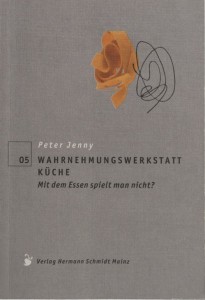
Wahrnehmungswerkstatt Küche
Mit dem Essen spielt man nicht?
Peter Jenny
Wie oft haben Sie das gehört? Denn es macht(e) Spass, das Innere des Brotchens zu kneten, glibbrige Gelatine zu beobachten, aus zufalligen Saucenklecksen kleine Gabel-Malereien zu machen. Wenn man genau hinschaut, sind Nudelnester ästhetische Kleinkunstwerke und aus Kirschenstilen lassen sich attraktive Reihungen legen. Als Kind hat uns das inspiriert, wir wollten in der Küche helfen – und patschen. Entdecken Sie die Wahrnehmungswerkstatt Küche mit Peter Jenny, sehen Sie Alltägliches mit neuen Augen. Der Abwasch des Tassenstapels wird zur künstlerischen Inspiration, Brokkoli zur Skulptur und Scherben bringen zum Glück auf neue Ideen.